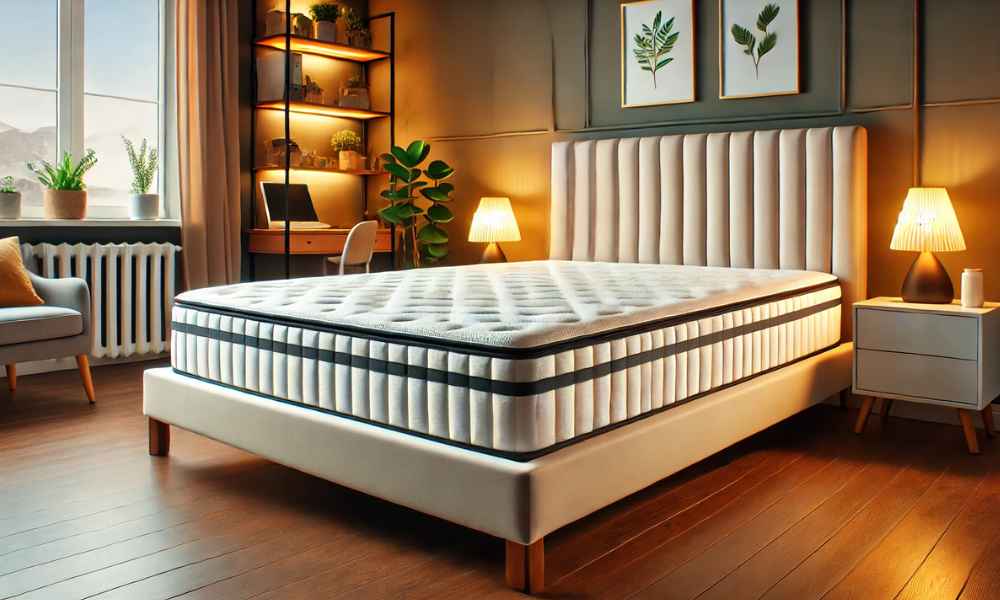A comfortable and stable mattress is essential for a good night’s sleep. However, if your mattress keeps sliding off the box spring, it can disrupt your rest and lead to discomfort. Many people struggle with this issue, unaware that simple solutions exist. Whether it’s caused by a lack of friction, an improper mattress-box spring pairing, or the bed frame design, understanding the root cause is the first step toward fixing the problem. By addressing these factors, you can enjoy uninterrupted, peaceful sleep without constantly adjusting your mattress. Stop Mattress From Sliding On Box Spring.
Why Does Your Mattress Keep Sliding? Common Causes Explained
A sliding mattress is more than just an inconvenience—it often indicates an issue with the bed’s foundation. One of the primary causes is the lack of friction between the mattress and the box spring. Many modern mattresses, particularly memory foam and latex types, have smooth bottoms that don’t grip traditional box springs well.
Another common cause is the absence of side rails on the bed frame. If your bed frame does not have a secure border, there’s nothing preventing the mattresses from shifting with movement. Additionally, an improper mattress size could be a contributing factor. If the mattress is slightly smaller than the box spring, it will naturally slide due to the extra space. Even uneven flooring can cause gradual mattresses movement. If your bed sits on a slanted or slightly unstable surface, gravity will encourage the mattress to shift over time. Frequent tossing and turning can also contribute, as repeated pressure can push the mattresses out of alignment.
The Problems Caused by a Sliding Mattress (And Why You Should Fix It ASAP)
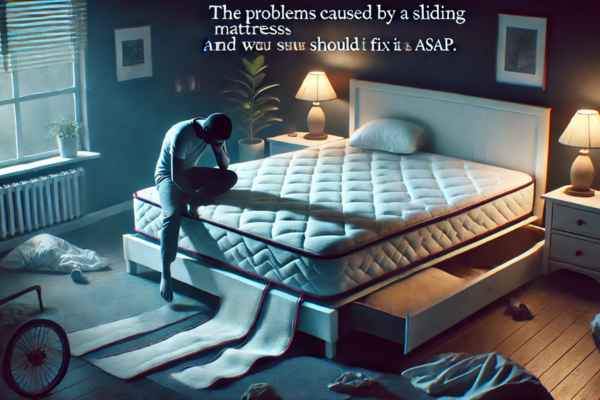
A mattress that won’t stay in place is more than just an annoyance; it can have negative consequences on your sleep quality, safety, and even the longevity of your bed. Interrupted sleep is the most immediate issue—constantly having to readjust your mattresses in the middle of the night prevents deep, restorative rest. Over time, poor sleep can impact your overall health, leading to fatigue, stress, and decreased focus.
Another major concern is potential injury. If your mattress slides too much, it could cause you to lose balance when sitting or getting out of bed. This is particularly dangerous for children and elderly individuals who rely on a stable sleeping surface. Additionally, a shifting mattresses can lead to wear and tear on your bed frame, box spring, and bedding. Constant movement can loosen bed slats, weaken frame joints, and even stretch out or damage your fitted sheets. By securing your mattress properly, you not only improve sleep quality but also extend the lifespan of your bed.
Check Your Mattress Type: Does It Contribute to Slipping?
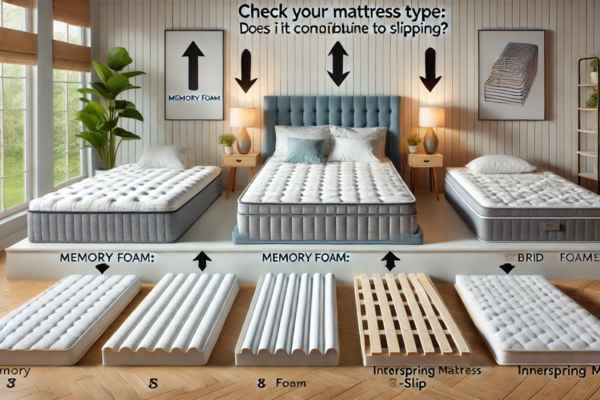
Different mattress types behave differently when placed on a box spring, and some are more prone to sliding than others. Memory foam and latex mattresses tend to be the most problematic because they are lightweight and have smooth, slippery undersides. Unlike traditional innerspring mattresses, which have a firmer, textured bottom, foam mattresses lack the friction needed to stay put.
Hybrid mattresses, which combine coils with foam layers, offer better grip than all-foam models, but they can still slide if the base layer is too smooth. Innerspring mattresses, due to their heavier weight and fabric-covered bottoms, generally stay in place more effectively. If you suspect your mattress type is the reason for its movement, consider using a non-slip mattress pad or a rubberized grip sheet underneath it. These solutions add friction and reduce unwanted shifting.
Assessing Your Box Spring: Is It the Culprit?
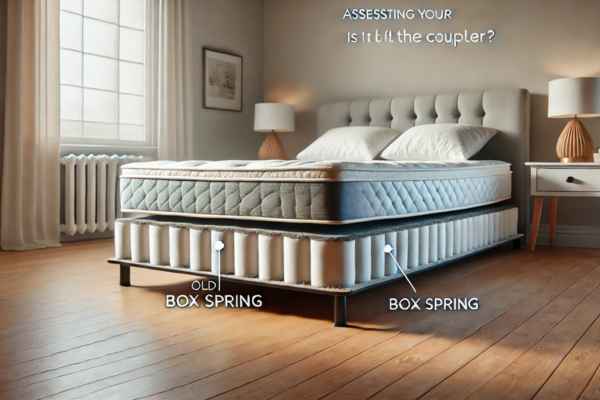
While the mattress itself plays a significant role in stability, the box spring beneath it is just as important. Older box springs can lose their structural integrity over time, leading to an uneven surface that encourages mattress movement. If your box spring is sagging, cracked, or showing signs of wear, it may need to be replaced.
Additionally, the material covering the box spring can affect how well your mattress stays in place. Traditional box springs with smooth fabric covers provide little to no grip, making it easier for mattresses to slide. In contrast, some newer models have textured or rubberized surfaces designed to prevent movement. Size compatibility is another crucial factor. If your box spring is slightly smaller or larger than your mattress, it can create instability, leading to gradual shifting. Ensuring a perfect fit between the mattresses and box spring is key to maintaining a secure sleeping surface.
Quick Fixes You Can Try Right Now
You’re looking for immediate solutions to stop your mattresses from sliding, you don’t always need fancy tools or expensive products. Some quick adjustments can significantly improve mattress stability.
1. Adjust Your Bed Frame
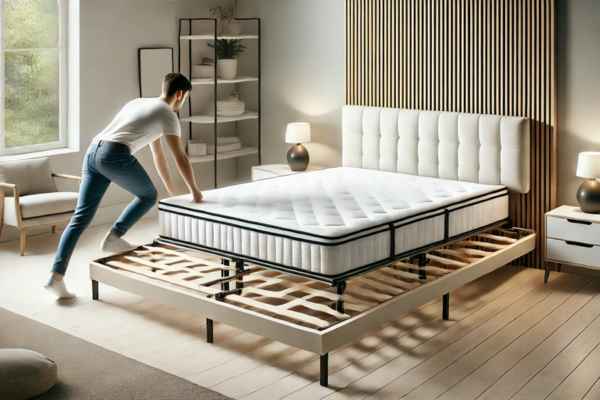
Your bed frame has extra space around the mattress, it may allow movement. Pushing the frame against a wall or using a headboard and footboard can help create a snug fit. If your bed frame lacks side rails, consider adding wooden or metal brackets to prevent shifting.
2. Rotate or Flip the Mattress
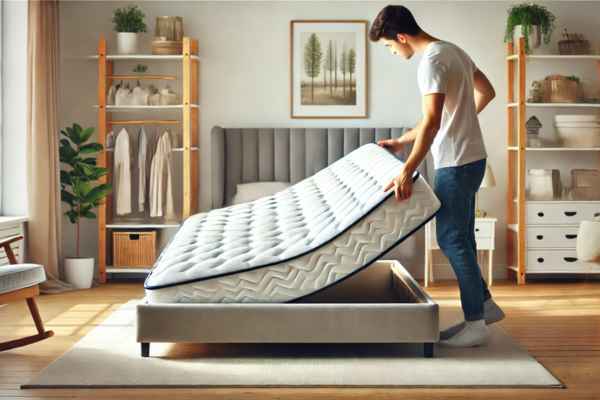
Over time, mattresses can develop smoother spots on the underside, reducing friction. If your mattress is double-sided, flipping it can provide a better grip. Even if it’s not, rotating it can sometimes improve stability.
3. Place a Rug Under the Bed
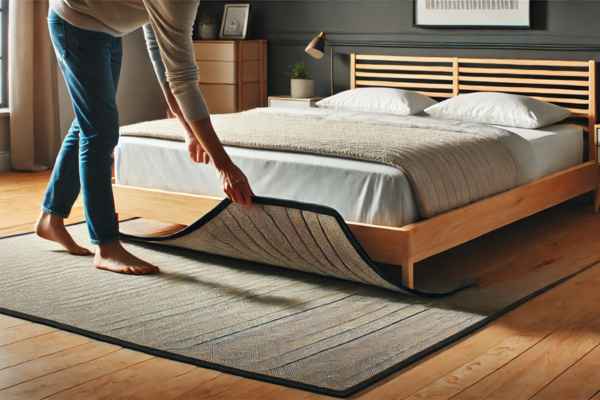
Your entire bed frame shifts on hardwood or tile flooring, placing a non-slip rug underneath can anchor the frame and indirectly prevent mattress movement.
4. Try Shelf Liners or Towels
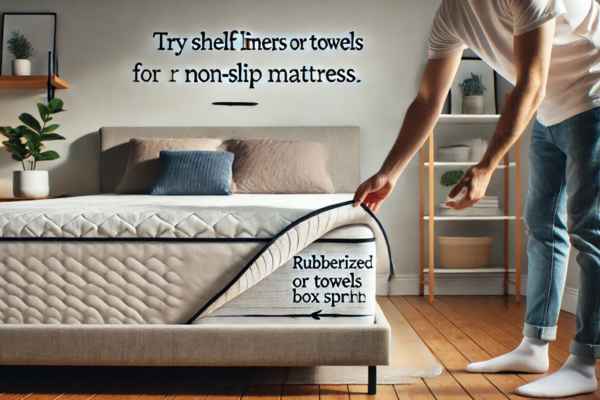
A simple yet effective DIY trick is to place non-slip shelf liners or rubberized towels between the mattresses and box spring. These materials add friction and help keep the mattress in place without any permanent alterations.
Non-Slip Mattress Pads: The Simple Yet Effective Solution
One of the easiest and most reliable solutions is using a non-slip mattress pad. These specially designed pads work by increasing friction between the mattresses and the box spring, keeping everything securely in place. Non-slip mattresses pads are typically made from rubberized, grippy materials that provide traction without damaging your mattress. They are available in various sizes, making it easy to find one that fits your bed perfectly. Simply placing the pad between your mattresses and box spring can significantly reduce unwanted movement. If you’re looking for a budget-friendly alternative, you can use rubber rug pads or grippy drawer liners instead. These household items function similarly to commercial non-slip mattress pads and can be an affordable substitute.
Using Rubber Matting for Instant Mattress Stability
You want a heavy-duty solution, rubber matting is an excellent choice. Rubber naturally provides a strong grip and prevents sliding, making it ideal for keeping a mattresses securely in place. To use rubber matting, cut a piece to match the size of your box spring and place it underneath the mattress. This technique works particularly well for memory foam and latex mattresses, which tend to have smoother undersides. Unlike some adhesives or tapes, rubber matting does not leave residue and can be easily removed or adjusted if needed. This method is also great for people who frequently adjust their bedding. Unlike Velcro or double-sided tape, rubber matting allows some flexibility while still keeping the mattresses firmly in place.
Velcro Strips: A Hidden Trick for a Firmly Placed Mattress
For those looking for a semi-permanent and discreet solution, Velcro strips can work wonders. This method involves attaching one side of the Velcro to the bottom of the mattress and the other to the box spring, effectively locking the two together.
How to apply Velcro strips for maximum hold:
- Choose industrial-strength Velcro – Regular Velcro may not have enough grip to hold a heavy mattress. Opt for heavy-duty Velcro designed for furniture or fabric use.
- Cut and attach strips – Apply several strips along the edges and center of the mattresses base for even distribution.
- Press firmly and secure – Once the Velcro is attached, press the mattress down onto the box spring to ensure a firm bond.
One major advantage of using Velcro is that it provides a strong yet removable solution. If you need to move your mattress for cleaning or rearranging, simply detach the Velcro and reattach it later without damage.
Double-Sided Carpet Tape: Does It Work for Mattresses?
Double-sided carpet tape is a simple yet effective way to keep your mattresses in place. This type of adhesive is designed to provide strong grip while remaining relatively easy to remove when needed. The tape works by creating a sticky bond between the bottom of the mattress and the box spring, preventing movement caused by tossing and turning. However, while carpet tape is affordable and easy to apply, it does have some drawbacks. Over time, the adhesive can lose its strength, requiring reapplication. Additionally, it may leave behind a sticky residue that can be difficult to remove, particularly on fabric-covered box springs. If you choose this method, opt for residue-free carpet tape designed for furniture or rugs to minimize mess.
Bed Frame Upgrades: Fixing Loose Slats & Adding Support
Your bed frame plays a crucial role in mattresses stability. If your mattress slides frequently, your bed frame may be loose, misaligned, or missing key support features. Over time, wooden slats can shift, screws may loosen, and gaps may widen, leading to unwanted movement. To fix this issue, start by tightening all screws and bolts to ensure a stable frame. If your bed has slats, check if they are evenly spaced and properly secured. Adding extra slats or a plywood base can provide additional support and create a firmer surface for the mattresses to rest on. Another effective upgrade is to install side rails or an adjustable headboard and footboard. These features act as natural barriers, preventing excessive mattress movement. If your current bed frame lacks these elements, consider upgrading to a model with a more secure structure.
Grip-Enhancing Mattress Covers: A Dual-Purpose Solution
A grip-enhancing mattress cover not only helps keep your mattresses in place but also provides an added layer of protection against spills, dust, and allergens. These covers are designed with a textured underside that increases friction between the mattresses and box spring, reducing slippage. When selecting a mattress cover for this purpose, look for rubberized, non-slip materials or covers that specifically advertise an anti-slip feature. Some covers even include adjustable straps that secure tightly around the mattress, ensuring it stays in place regardless of movement. This solution is especially useful for those who want to maintain aesthetics and hygiene while preventing mattresses movement. Unlike adhesive-based methods, a non-slip cover won’t leave residue and is easily washable.
Rubber Sheet Hack: The Budget-Friendly Solution That Works
You’re looking for a cost-effective and non-invasive way to stop your mattress from sliding, a simple rubber sheet could be the answer. Rubber naturally provides excellent grip, making it an ideal material for stabilizing a mattresses on a box spring. To use this hack, cut a rubber sheet (such as a yoga mat, anti-slip rug pad, or rubber drawer liner) to match the size of your mattress base. Place it between the mattresses and box spring, and you’ll instantly notice reduced movement. The benefit of this method is that it requires no adhesives, screws, or modifications to your bed frame. It’s also removable and reusable, making it a flexible option for those who may need to adjust their sleeping setup frequently.
DIY Methods: Home Remedies to Keep Your Mattress in Place
You prefer household solutions, several DIY methods can effectively prevent mattresses movement. Here are a few easy options:
- Towel Trick: Rolling up towels and placing them along the edges of the mattresses can create a barrier that minimizes shifting.
- Shelf Liner Method: Cut pieces of rubberized shelf liners and place them under each corner of the mattress for extra grip.
- Pool Noodles Hack: Placing pool noodles between the mattresses and bed frame helps keep the mattress centered and secure.
- Velcro Strips: Attaching strong Velcro strips between the mattresses and box spring provides a discreet yet effective fix.
These DIY solutions are great for temporary or budget-conscious fixes and can be adjusted based on your needs.
When to Replace Your Mattress or Box Spring for a More Secure Sleep
You’ve tried multiple solutions but your mattresses still slides frequently, it might be time to consider a replacement. An old or worn-out mattress can lose its shape, reducing its ability to stay in place. Likewise, a sagging or unstable box spring may not provide the necessary support for your mattress.
Signs that it’s time for a new mattresses or box spring include:
- Visible sagging or indentations in the mattress.
- Persistent sliding despite multiple grip-enhancing solutions.
- Noise or instability in the box spring or bed frame.
- Discomfort and poor sleep quality.
Upgrading to a high-quality, well-fitted mattress and box spring can eliminate movement issues and enhance overall sleep comfort.
Final Tips for a Slip-Free Mattress & Restful Nights
To ensure long-term stability and comfort, follow these final tips:
- Ensure your mattress and box spring are the same size to prevent unnecessary movement.
- Invest in non-slip accessories like mattresses pads, covers, or rubber mats.
- Check your bed frame regularly for loose slats or screws that could contribute to instability.
- Use side rails, headboards, or footboards to keep your mattress in place.
- Consider replacing old bedding components if they no longer provide proper support.
By taking these steps, you can enjoy a slip-free, stable mattresses that enhances your sleep quality and comfort. A well-secured mattresses means fewer nighttime disruptions and a more restful, rejuvenating sleep experience.
Conclusion
A sliding mattress can be a frustrating and disruptive issue, but fortunately, there are numerous solutions to keep it securely in place. From quick fixes like adjusting your bed frame or using double-sided carpet tape to more long-term solutions such as non-slip mattresses pads, rubber matting, and Velcro strips, there are plenty of options to choose from based on your needs and budget. Ensuring that your bed frame, box spring, and mattress are compatible is also essential for maintaining stability. Simple upgrades like adding side rails, fixing loose slats, or using grip-enhancing mattresses covers can make a significant difference. If your mattresses continues to slide despite multiple fixes, it may be time to replace a worn-out mattresses or box spring for better support and comfort.
